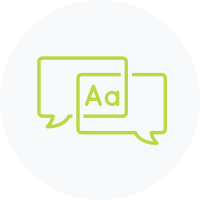The vocabulary/language mini-lessons support students and teachers with vocabulary knowledge and skills. The mini-lessons are written for specific texts, which teachers need to access for instruction. Teachers can also adapt them to other texts or even other grades. The mini-lessons cover language standards L.4 and L.5, which are the standards with greatest focus on vocabulary as it applies to reading.
| LANGUAGE STANDARD | ASSOCIATED WHEATLEY TEXTS | ASSOCIATED WHEATLEY READING LESSONS | |||||
|---|---|---|---|---|---|---|---|
| M1 | M2 | M3 | M4 | M5 | |||
| L.2.4 | Determine or clarify the meaning of unknown and multiple-meaning words and phrases based on grade 2 reading and content, choosing flexibly from an array of strategies. | Journey of a Pioneer | 4 | ||||
| L.2.4.A | Use sentence-level context as a clue to the meaning of a word or phrase. | “Weather” | 2 | ||||
“Something Told the Wild Geese” | 11 | ||||||
Martin Luther King, Jr. and the March on Washington | 1 | ||||||
| L.2.4.B | Determine the meaning of the new word formed when a known prefix is added to a known word (e.g., happy/unhappy, tell/retell). | Pop’s Bridge | 14 | ||||
“Ruby Bridges Interview” | 19 | ||||||
| L.2.4.C | Use a known root word as a clue to the meaning of an unknown word with the same root (e.g., addition, additional). | The Golden Gate Bridge | 4 | ||||
Four Feet, Two Sandals | 28 | ||||||
Good Enough to Eat | 1 | ||||||
| L.2.4.D | Use knowledge of the meaning of individual words to predict the meaning of compound words (e.g., birdhouse, lighthouse, housefly; bookshelf, notebook, bookmark). | Mackinac Bridge | 17 | ||||
| L.2.4.E | Use glossaries and beginning dictionaries, both print and digital, to determine or clarify the meaning of words and phrases. | Abraham Lincoln: Lawyer, Leader, Legend | 25 | ||||
| L.2.5 | Demonstrate understanding of word relationships and nuances in word meanings. | ||||||
| L.2.5.A | Identify real-life connections between words and their use (e.g., describe foods that are spicy or juicy). | The Little Yellow Leaf | 16 | ||||
Why Do Leaves Change Color? | 23 | ||||||
The Legend of the Indian Paintbrush | 22 | ||||||
| L.2.5.B | Distinguish shades of meaning among closely related verbs (e.g., toss, throw, hurl) and closely related adjectives (e.g., thin, slender, skinny, scrawny). | Pop’s Bridge | 13 | ||||
Martin Luther King, Jr. and the March on Washington | 5 | ||||||
GRADE 2: MODULE 1
| Weather L.2.4.A |
|---|
Introduce the Vocabulary Learning Objective
Check Vocabulary Skills
Reteach
Vocabulary Exit Ticket
Reteach
|
| Something Told the Wild Geese L.2.4.A |
Introduce the Vocabulary Learning Objective
Check Vocabulary Skills
Sample Student Responses:
Reteach
Vocabulary Exit Ticket
|
| The Little Yellow Leaf L.2.5.A |
Introduce the Vocabulary Learning Objective
Check Vocabulary Skills
Reteach
Vocabulary Exit Ticket
Reteach
|
| Why Do Leaves Change Color? L.2.5.A |
Introduce the Vocabulary Learning Objective
Check Vocabulary Skills
Reteach
Vocabulary Exit Ticket
Sample Student Response
Reteach
|
GRADE 2: MODULE 2
| Journey of a Pioneer L.2.4 |
|---|
Introduce the Vocabulary Learning Objective
Check Vocabulary Skills
Reteach
Vocabulary Exit Ticket
Reteach
|
| The Legend of the Indian Paintbrush L.2.5.A |
Advance Preparation
Introduce the Vocabulary Learning Objective
Sample Student Responses:
Vocabulary Exit Ticket
Reteach
|
GRADE 2: MODULE 3
| Pop’s Bridge L.2.4.B |
|---|
Advance Preparation
Introduce the Vocabulary Learning Objective
Vocabulary Exit Ticket
Sample Student Response:
Reteach
|
| The Golden Gate Bridge L.2.4.C |
Introduce the Vocabulary Learning Objective
Check Vocabulary Skills
Reteach
Vocabulary Exit Ticket
Sample Student Responses:
Reteach
|
| Four Feet, Two Sandals L.2.4.C |
Advance Preparation
Introduce the Vocabulary Learning Objective
Vocabulary Exit Ticket
Sample Student Responses:
Reteach
|
| Mackinac Bridge L.2.4.D |
Advance Preparation
Introduce the Vocabulary Learning Objective
Check Vocabulary Skills
Reteach
Vocabulary Exit Ticket
Reteach
|
| Pop’s Bridge L.2.5.B |
Advance Preparation
Introduce the Vocabulary Learning Objective
Check Vocabulary Skills
Reteach
Vocabulary Exit Ticket
stroll walk proudly
march walk quietly on your tiptoes
tiptoe walk in a relaxed way
strut walk with your knees raised
Sample Student Responses: stroll: walk in a relaxed way; march: walk with your knees raised; tiptoe: walk quietly on your tiptoes; strut: walk proudly Reteach
|
GRADE 2: MODULE 4
| Martin Luther King, Jr. and the March on Washington L.2.4.A |
||||||||||||||||||||
|---|---|---|---|---|---|---|---|---|---|---|---|---|---|---|---|---|---|---|---|---|
Advance Preparation
Materials
Introduce the Vocabulary Learning Objective
Check Vocabulary Skills
Reteach
Vocabulary Exit Ticket
Reteach
| ||||||||||||||||||||
| “Ruby Bridges Interview” (http://www.scholastic.com/teachers/asset/ruby-bridges-interview) L.2.4.B | ||||||||||||||||||||
Advanced Preparation
Materials
Introduce the Vocabulary Learning Objective
Check Vocabulary Skills
Reteach
Vocabulary Exit Ticket
Reteach
Handout: Vocabulary ChartDirections: Read the word. Determine the meaning of a new word when a prefix is added.
| ||||||||||||||||||||
| Abraham Lincoln: Lawyer, Leader, Legend: L.2.4.E | ||||||||||||||||||||
Advance Preparation
Materials
Introduce the Vocabulary Learning Objective
Check Vocabulary Skills
Reteach
Vocabulary Exit Ticket
Reteach
| ||||||||||||||||||||
| Martin Luther King and the March on Washington L.2.5.B | ||||||||||||||||||||
Advance Preparation
Materials
Introduce the Vocabulary Learning Objective
Check Vocabulary Skills
Reteach
Vocabulary Exit Ticket
Reteach
|
GRADE 2: MODULE 5
| Bone Button Borscht L.1.4.A |
|---|
Advance Preparation
Introduce the Vocabulary Learning Objective
Check Vocabulary Skills
Reteach
Vocabulary Exit Ticket
Sample Student Responses: perfectly: in a perfect way, in a way that has no mistakes, completely Reteach
|
| Good Enough to Eat L.2.5.A |
Materials
Introduce the Vocabulary Learning Objective
Check Vocabulary Skills
Reteach
Vocabulary Exit Ticket
Reteach
|
| Bone Button Borscht L.2.5.B |
Materials
Advance Preparation
Introduce the Vocabulary Learning Objective
Check Vocabulary Skills
Reteach
Vocabulary Exit Ticket
Reteach
|
| Strega Nana Strega Nana: Her Story L.2.5.B |
Advance Preparation
Introduce the Vocabulary Learning Objective
Check Vocabulary Skills
Reteach
Vocabulary Exit Ticket
Reteach
|
